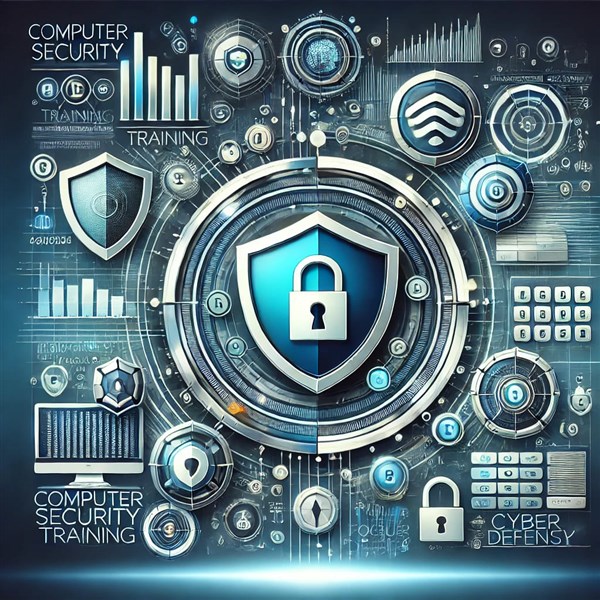
In an age where digital threats loom larger than ever before, understanding computer security is no longer optional — it’s essential. Every organization, from startups to global enterprises, depends on secure systems to protect sensitive data, maintain customer trust, and comply with legal regulations. But safeguarding these systems requires more than just a firewall or antivirus software — it demands skilled professionals equipped with real-world knowledge and critical thinking.
This is where computer security training comes in.
Whether you're an aspiring IT professional, a business owner, or someone working in a security-conscious environment, understanding the basics of computer security training is your first step toward defending against cyber threats. In this blog, we’ll explore what you’ll learn in a foundational computer security training program — including the key concepts, tools, best practices, and skills that form the backbone of modern cybersecurity.
📚 What Is Computer Security Training?
Computer security training, often referred to as cybersecurity training, is a structured program designed to teach individuals how to identify, prevent, and respond to digital threats targeting computers, networks, systems, and data.
Training programs can range from beginner-level awareness courses to advanced certification paths. Regardless of the level, the goal remains the same: to reduce risk by strengthening your understanding of digital threats and your ability to defend against them.
🔍 Core Concepts You’ll Learn in Computer Security Training
Let’s dive into the fundamental areas you’ll typically cover in an introductory to intermediate computer security course.
1️⃣ Understanding Threats, Vulnerabilities, and Attacks
Before you can defend a system, you need to understand what you’re defending against.
What You'll Learn:
- Definitions of threats, vulnerabilities, and exploits
- Common types of cyberattacks: malware, phishing, ransomware, DDoS, etc.
- Threat actors: hackers, insiders, nation-states, and cybercriminal groups
- Real-world attack scenarios and case studies
Why It Matters:
This foundational knowledge helps you recognize potential dangers early and respond appropriately — whether you're setting up a secure network or spotting phishing attempts in your inbox.
2️⃣ Network Security Basics
Computer systems don’t operate in isolation. Network security is a crucial part of any training program and helps ensure that data moving between devices is protected.
What You'll Learn:
- Basics of network protocols: TCP/IP, DNS, HTTP/HTTPS
- Firewalls and intrusion detection systems (IDS)
- VPNs and encrypted communications
- Network segmentation and access control
Why It Matters:
Understanding how data flows through networks enables you to secure endpoints, monitor traffic, and detect suspicious activity before damage occurs.
3️⃣ Authentication, Authorization, and Access Control
One of the most critical aspects of security is controlling who has access to what.
What You'll Learn:
- Multi-factor authentication (MFA)
- Password policies and secure credentials management
- Role-based access control (RBAC)
- Single Sign-On (SSO) systems
Why It Matters:
Even the best security system can be compromised if the wrong person gains access. This module teaches you how to ensure that only authorized users can interact with sensitive systems.
4️⃣ Endpoint and Malware Protection
Devices like laptops, desktops, mobile phones, and servers are common targets for cyberattacks. In training, you’ll learn how to secure these endpoints.
What You'll Learn:
- Identifying and removing viruses, worms, Trojans, and spyware
- Installing and configuring antivirus/anti-malware tools
- Endpoint Detection and Response (EDR) tools
- System hardening techniques
Why It Matters:
Endpoints are often the weakest link in a network. Learning how to protect, monitor, and respond to attacks on these devices is crucial.
5️⃣ Email and Social Engineering Awareness
Humans are often the most vulnerable part of any security system. That’s why social engineering is a major focus in most training programs.
What You'll Learn:
- Recognizing phishing emails and fake websites
- Social engineering attack techniques (pretexting, baiting, tailgating)
- Security awareness training best practices
- Reporting suspicious activity
Why It Matters:
Many breaches occur not through software vulnerabilities but through manipulation of human behavior. Training helps you become a stronger line of defense.
6️⃣ Security Policies, Compliance, and Governance
Cybersecurity doesn’t operate in a vacuum. You’ll also explore how laws, standards, and corporate policies shape secure operations.
What You'll Learn:
- Overview of data protection laws (GDPR, HIPAA, CCPA)
- Creating and enforcing internal security policies
- Understanding compliance audits and risk assessments
- Introduction to governance frameworks (NIST, ISO/IEC 27001)
Why It Matters:
Many industries are governed by strict regulations, and compliance failures can result in heavy fines or reputational damage. Training ensures you’re aware of your legal and ethical responsibilities.
7️⃣ Incident Response and Recovery
Even with the best defenses, breaches can still happen. That’s why you’ll learn how to react swiftly and effectively to minimize damage.
What You'll Learn:
- Steps in the incident response lifecycle (prepare, detect, respond, recover)
- Creating incident response plans
- Backup and disaster recovery strategies
- Post-incident analysis and reporting
Why It Matters:
Your ability to recover quickly and learn from security events can be the difference between a minor disruption and a business disaster.
🧰 Tools You’ll Use in Computer Security Training
Modern training programs are hands-on and introduce students to real-world tools like:
- Wireshark (packet analysis)
- Kali Linux (penetration testing)
- Nmap (network scanning)
- Snort (intrusion detection)
- Splunk or ELK Stack (log analysis and SIEM)
- Metasploit (exploit framework)
These tools help reinforce learning by simulating real attack and defense scenarios.
🧑💻 Who Should Take Computer Security Training?
Computer security training is useful for:
- IT professionals seeking cybersecurity roles
- Students pursuing technology degrees
- Small business owners looking to protect their systems
- Employees needing security awareness in remote or hybrid work environments
- Executives seeking to understand risk and compliance
🏆 Certifications to Consider After Training
To validate your skills and improve job prospects, consider certifications such as:
- CompTIA Security+ (entry-level)
- Certified Ethical Hacker (CEH)
- Certified Information Systems Security Professional (CISSP)
- Cisco Certified CyberOps Associate
These globally recognized credentials show employers you’re trained and serious about security.
🧭 Conclusion
Computer security training provides more than just technical knowledge — it delivers peace of mind, career readiness, and operational resilience. By covering essential concepts like threat detection, network defense, endpoint protection, and compliance, these programs prepare individuals to safeguard both personal and professional digital environments.
In a world where cyberattacks are no longer a question of if but when, computer security training is your first line of defense — and possibly your greatest asset.
✅ Final Takeaway:
Whether you're looking to enter the cybersecurity field or just want to better protect your digital assets, computer security training gives you the skills and confidence to defend against today’s most pressing cyber threats.
At Koenig Solutions, we offer comprehensive computer security training courses designed to equip you with the skills needed to protect your systems and data against modern cyber threats. Our experienced trainers provide hands-on training, ensuring you can apply your newfound knowledge in real-world situations. With a wide range of courses and flexible training schedules, we're committed to providing the best learning experience for our students.


Training.jpgM.jpg)




COMMENT